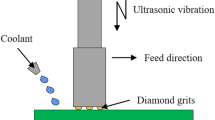Abstract
Ultrasonic-assisted grinding has been increasingly investigated for its advanced machining capability for hard-to-machine materials. Ultrasonic-assisted micro end grinding (UAMEG) is a promising technology to improve machining performance of conventional micro end grinding. Interrupted cutting is one of the most important points for UAMEG. The critical conditions for achieving interrupted cutting are investigated by modeling and simulation of adjacent abrasive trajectories. In addition, the abrasive-work impact effect is researched by modeling and simulation of abrasive velocity and acceleration. As a result, the critical conditions are worked out to be as follows: the frequency coefficient k is a positive integer, and feed-amplitude rate λ is equal to 2. High level of impact effect is generated between abrasive and unmachined material. Micro end grinding experiments of silica glass with and without ultrasonic vibration are conducted for verification. The investigation of the results of measured grinding force and surface topography indicates that UAMEG is an efficient machining method to improve the present micro end grinding by significant grinding force reduction and surface quality improvement.
Similar content being viewed by others
References
Masuzawa T (2000) State of the art of micromachining. CIRP Ann-Manuf Technol 49:473–488
Brinksmeier E, Mutlugunes Y, Klocke F, Aurich JC, Shore P, Ohmori H (2010) Ultra-precision grinding. CIRP Ann Manuf Technol 59:652–671
Chae J, Park SS, Freiheit T (2006) Investigation of micro-cutting operations. Int J Mach Tools Manuf 46:313–332
Liow JL (2009) Mechanical micromachining: a sustainable micro-device manufacturing approach. J Clean Prod 17:662–667
Bathurst SP, Kim SG (2013) Printing of uniform PZT thin films for MEMS applications. CIRP Ann Manuf Technol 62:227–230
Mehran M, Christian AZ (1999) SiC MEMS: opportunities and challenges for applications in harsh environments. Thin Solid Films 355–356:518–524
Masako T (2007) An industrial and applied review of new MEMS devices features. Microelectron Eng 84:1341–1344
Zhong ZW, Venkatesh VC (2009) Recent developments in grinding of advanced materials. Int J Adv Manuf Technol 41:468–480
Ramesh K, Huang H, Yin L, Zhao J (2004) Microgrinding of deep micro grooves with high table reversal speed. Int J Mach Tools Manuf 44:39–49
Perveen A, Jahan MP, Rahman M, Wong YS (2012) A study on microgrinding of brittle and difficult-to-cut glasses using on-machine fabricated poly crystalline diamond (PCD) tool. J Mater Process Technol 212:580–593
Dornfeld D, Min S, Takeuchi Y (2006) Recent advances in mechanical micro-machining. CIRP Ann Manuf Technol 55:745–768
Feng J, Kim BS, Shih A (2009) Ni Tool wear monitoring for micro-end grinding of ceramic materials. J Mater Process Technol 209:5110–5116
Brehl DE, Dow TA (2008) Review of vibration-assisted machining. Precis Eng 32:153–172
Nath C, Rahman M (2008) Effect of machining parameters in ultrasonic vibration cutting. Int J Mach Tools Manuf 48:965–974
Junichiro K (1982) Precision machining and vibration assisted cutting (base and application). China Machine PRESS, Beijing
Gan J, Wang X, Zhou M, Ngoi B, Zhong Z (2003) Ultraprecision diamond turning of glass with ultrasonic vibration. Int J Adv Manuf Technol 21:952–955
Tawakoli T, Bahman A, Mohammad R (2009) Ultrasonic assisted dry grinding of 42CrMo4. Int J Adv Manuf Technol 42:883–891
Tawakoli T, Bahman A (2008) Influence of ultrasonic vibrations on dry grinding of soft steel. Int J Mach Tools Manuf 48:1585–1591
Yan YY, Zhao B, Liu JL (2009) Ultraprecision surface finishing of nano-ZrO2 ceramics using two-dimensional ultrasonic assisted grinding. Int J Adv Manuf Technol 43(5–6):462–467
Chen HF, Tang JY, Zhou W (2013) An experimental study of the effects of ultrasonic vibration on grinding surface roughness of C45 carbon steel. Int J Adv Manuf Technol 68:2095–2098
Prasanna MM, Miehele HM (2014) Force and thermal effects in vibration-assisted grinding. Int J Adv Manuf Technol 71:1117–1122
Wang Y, Lin B, Zhang XF (2014) Research on the system matching model in ultrasonic vibration-assisted grinding. Int J Adv Manuf Technol 70:449–458
Akbari J, Borzoie H, Mamduhi MH (2008) Study on ultrasonic vibration effects on grinding process of alumina ceramic (Al2O3). World Acad Sci Eng Technol 41:785–789
Rowe WB, Black SCE, Mills B (1997) Grinding temperatures and energy partitioning. R Soc 61:1083–1104
Muhammad A, Rahman M, San WY (2011) Analytical model to determine the critical feed per edge for ductile–brittle transition in milling process of brittle materials. Int J Mach Tools Manuf 51:170–181
Marshall DB, Lawn BR (1986) Indentation of brittle materials. In: Blau PJ, Lawn BR (eds) Microindentation techniques in materials science and engineering. American Society for Testing and Materials, Philadelphia, pp 26–46
Author information
Authors and Affiliations
Corresponding author
Rights and permissions
About this article
Cite this article
Jian-Hua, Z., Yan, Z., Fu-Qiang, T. et al. Kinematics and experimental study on ultrasonic vibration-assisted micro end grinding of silica glass. Int J Adv Manuf Technol 78, 1893–1904 (2015). https://doi.org/10.1007/s00170-014-6761-z
Received:
Accepted:
Published:
Issue Date:
DOI: https://doi.org/10.1007/s00170-014-6761-z



